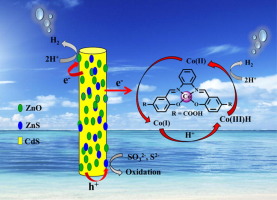Journal of Catalysis ( IF 6.5 ) Pub Date : 2017-08-14 , DOI: 10.1016/j.jcat.2017.06.010 Rana Muhammad Irfan , Daochuan Jiang , Zijun Sun , Lei Zhang , Shengsheng Cui , Pingwu Du

|
Photocatalytic hydrogen production is considered to be a promising solution to the global energy crisis and to environmental pollution caused by fossil fuel consumption. In the present study, a core/shell cadmium sulfide/zinc oxide (ZnO/CdS) semiconductor heterojunction photocatalyst is used with a cobalt–salen molecular co-catalyst for highly enhanced photocatalytic activity. CdS nanorods were synthesized using a simple solvothermal method and a ZnO shell was grown by a solution deposition method. Under optimum conditions, the system exhibited a H2 evolution rate of 725 µmol h−1 mg−1 with a turnover number of ∼102,700 and excellent stability over 50 h in the presence of Na2S/Na2SO3 as the electron donor under visible light. The highest apparent quantum yield of the system was 44% under monochromatic 420 nm light. The formation of ZnS during photocatalysis was proved due to surface dissolution of ZnO in alkaline sulfide solution. ZnS can enhance the photocatalytic activity of ZnO/CdS nanorods by providing increased charge transfer interfaces. The molecular cobalt co-catalyst also contributed to the enhanced activity by accepting the photogenerated electrons from the semiconductor photosensitizer. The proposed mechanism suggests that the photogenerated electrons in CdS are transferred not only to ZnO but also to the molecular co-catalysts, leading to highly improved photocatalytic activity for H2 production.
中文翻译:

将分子助催化剂与非均相半导体异质结光催化剂结合:具有两个电子转移途径的新型机理,可增强太阳光氢的产生
光催化制氢被认为是解决全球能源危机和化石燃料消耗造成的环境污染的有前途的解决方案。在本研究中,核/壳硫化镉/氧化锌(ZnO / CdS)半导体异质结光催化剂与钴-salen分子助催化剂一起使用可大大增强光催化活性。使用简单的溶剂热法合成CdS纳米棒,并通过溶液沉积法生长ZnO壳。在最佳条件下,该系统在Na 2 S / Na 2 SO 3存在下,H 2的析出速率为725 µmol h -1 mg -1,周转数约为102,700,并且在50 h内具有出色的稳定性。作为可见光下的电子供体 在单色420 nm光下,该系统的最高表观量子产率为44%。ZnS在碱性硫化物溶液中的表面溶解证明了光催化过程中ZnS的形成。ZnS可通过提供增加的电荷转移界面来增强ZnO / CdS纳米棒的光催化活性。分子钴助催化剂还通过接受来自半导体光敏剂的光生电子来增强活性。拟议的机制表明,CdS中的光生电子不仅转移到ZnO,而且转移到分子助催化剂,从而大大提高了H 2产生的光催化活性。











































 京公网安备 11010802027423号
京公网安备 11010802027423号